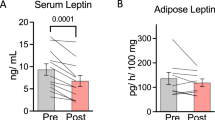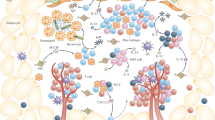Abstract
Recent evidence indicates that adipose tissue macrophages and lymphocytes have a major role in the pathophysiology of obesity. The arterio-venous (A–V) difference technique has been used very effectively to understand adipose tissue metabolism in humans in vivo, and we set out to investigate whether it is possible to apply and use this technique to determine A–V differences for peripheral blood mononuclear cells (PBMCs) across human adipose tissue. We used flow-cytometric analysis of arterial blood and venous blood draining upper- (abdominal) and lower-body (femoral) adipose tissue depots in middle-aged volunteers (age 45±8 years, BMI 25.9±4.1 kg m−2). We determined A–V differences for various PBMCs. In basal conditions, there was evidence of modest retention of some PBMCs in adipose tissue, whereas the infusion of low-dose (physiological) adrenaline led to a marked release of many PBMCs (with little evidence of depot-specific differences). In addition to the demonstration that this approach is technically feasible, these results also indicate that physiological stimuli that change adrenaline concentrations and/or adipose tissue blood flow (such as physical activity) provoke the release of PBMCs from femoral and abdominal adipose depots.
This is a preview of subscription content, access via your institution
Access options
Subscribe to this journal
Receive 12 print issues and online access
$259.00 per year
only $21.58 per issue
Buy this article
- Purchase on Springer Link
- Instant access to full article PDF
Prices may be subject to local taxes which are calculated during checkout


Similar content being viewed by others
References
Frayn KN, Fielding BA, Karpe F . Adipose tissue fatty acid metabolism and cardiovascular disease. Curr Opin Lipidol 2005; 16: 409–415.
Macdonald IA . Arterio-venous differences to study macronutrient metabolism: introduction and overview. Proc Nutr Soc 1999; 58: 871–875.
Bourlier V, Bouloumie A . Role of macrophage tissue infiltration in obesity and insulin resistance. Diabetes Metab 2009; 35: 251–260.
Winer S, Chan Y, Paltser G, Truong D, Tsui H, Bahrami J et al. Normalization of obesity-associated insulin resistance through immunotherapy. Nat Med 2009; 15: U921–U126.
Feuerer M, Herrero L, Cipolletta D, Naaz A, Wong J, Nayer A et al. Lean, but not obese, fat is enriched for a unique population of regulatory T cells that affect metabolic parameters. Nat Med 2009; 15: U930–U137.
Duffaut C, Zakaroff-Girard A, Bourlier V, Decaunes P, Maumus M, Chiotasso P et al. Interplay between human adipocytes and T lymphocytes in obesity. CCL20 as an adipochemokine and T lymphocytes as lipogenic modulators. Arterioscler Thromb Vasc Biol 2009; 29: 1608–1614.
Bourlier V, Zakaroff-Girard A, Miranville A, De Barros S, Maumus M, Sengenes C et al. Remodeling phenotype of human subcutaneous adipose tissue macrophages. Circulation 2008; 117: 806–815.
Anderson EK, Gutierrez DA, Hasty AH . Adipose tissue recruitment of leukocytes. Curr Opin Lipidol 2010; 21: 172–177.
Coppack SW, Frayn KN, Humphreys SM, Whyte PL, Hockaday TDR . Arteriovenous differences across human adipose and forearm tissues after overnight fast. Metab Clin Exp 1990; 39: 384–390.
McQuaid SE, Manolopoulos KN, Dennis AL, Cheeseman J, Karpe F, Frayn KN . Development of an arterio-venous difference method to study the metabolic physiology of the femoral adipose tissue depot. Obesity 2010; 18: 1055–1058.
Karpe F, Fielding BA, Ilic V, Humphreys SM, Frayn KN . Monitoring adipose tissue blood flow in man: a comparison between the (133)xenon washout method and microdialysis. Int J Obesity 2002; 26: 1–5.
Matthews JNS, Altman DG . Statistics notes: Interaction 2: compare effect sizes not P values. Br Med J 1996; 313: 808.
Burns AM, Keogan M, Donaldson M, Brown DL, Park GR . Effects of inotropes on human leucocyte numbers, neutrophil function and lymphocyte subtypes. Br J Anaesthesia 1997; 78: 530–535.
Dimitrov S, Lange T, Born J . Selective mobilization of cytotoxic leukocytes by epinephrine. J Immunol 2010; 184: 503–511.
Søndergaard SR, Ullum H, Skinhøj P, Pedersen BK . Epinephrine-induced mobilization of Natural Killer (NK) cells and NK-like T cells in HIV-infected patients. Cell Immunol 1999; 197: 91–98.
Manolopoulos KN, Karpe F, Frayn KN . Gluteofemoral body fat as a determinant of metabolic health. Int J Obes 2010; 34: 949–959.
McMurray RG, Forsythe WA, Mar MH, Hardy CJ . Exercise intensity-related responses of beta-endorphin and catecholamines. Med Sci Sports Exerc 1987; 19: 570–574.
Henderson GC, Fattor JA, Horning MA, Faghihnia N, Johnson ML, Mau TL et al. Lipolysis and fatty acid metabolism in men and women during the postexercise recovery period. J Physiol-London 2007; 584: 963–981.
Moro C, Pillard F, de Glisezinski I, Crampes F, Thalamas C, Harant I et al. Sex differences in lipolysis-regulating mechanisms in overweight subjects: effect of exercise intensity. Obesity 2007; 15: 2245–2255.
Moro C, Pillard F, de Glisezinski I, Klimcakova E, Crampes F, Thalamas C et al. Exercise-induced lipid mobilization in subcutaneous adipose tissue is mainly related to natriuretic peptides in overweight men. Am J Physiol-Endocrinol Metab 2008; 295: E505–E513.
Acknowledgements
DT was supported by a 12-month sabbatical from the University of Bath and KNM by the Wellcome Trust. This study was supported in part by the NIHR Oxford Biomedical Research Centre and the Commission of the European Communities Collaborative Project ADAPT (www.adapt-eu.net), HEALTH-F2-2008-2011-00. DT was hosted by Professors Keith Frayn and Fredrik Karpe (Oxford) and Dr Anne Bouloumié (Toulouse) during his sabbatical. We thank Alexia Girard and Marie-Laure Renoud for their technical support.
Author information
Authors and Affiliations
Corresponding author
Ethics declarations
Competing interests
The authors declare no conflict of interest.
Additional information
Supplementary Information accompanies the paper on International Journal of Obesity website
Supplementary information
Rights and permissions
About this article
Cite this article
Thompson, D., Manolopoulos, K. & Bouloumié, A. Arterio-venous differences in peripheral blood mononuclear cells across human adipose tissue and the effect of adrenaline infusion. Int J Obes 36, 1256–1258 (2012). https://doi.org/10.1038/ijo.2011.219
Received:
Revised:
Accepted:
Published:
Issue Date:
DOI: https://doi.org/10.1038/ijo.2011.219



